There really should be no battle between the Snow Queen Pothos and The Marble Queen Pothos as they are both beautiful houseplants that have much more in common than what separates them.
As a result, it’s actually quite easy to confuse the two plants.
This guide will look at the similarities and differences of the two pothos varieties – Snow Queen vs Marble Queen Pothos.
Snow Queen vs Marble Queen Pothos: Similarities and Differences
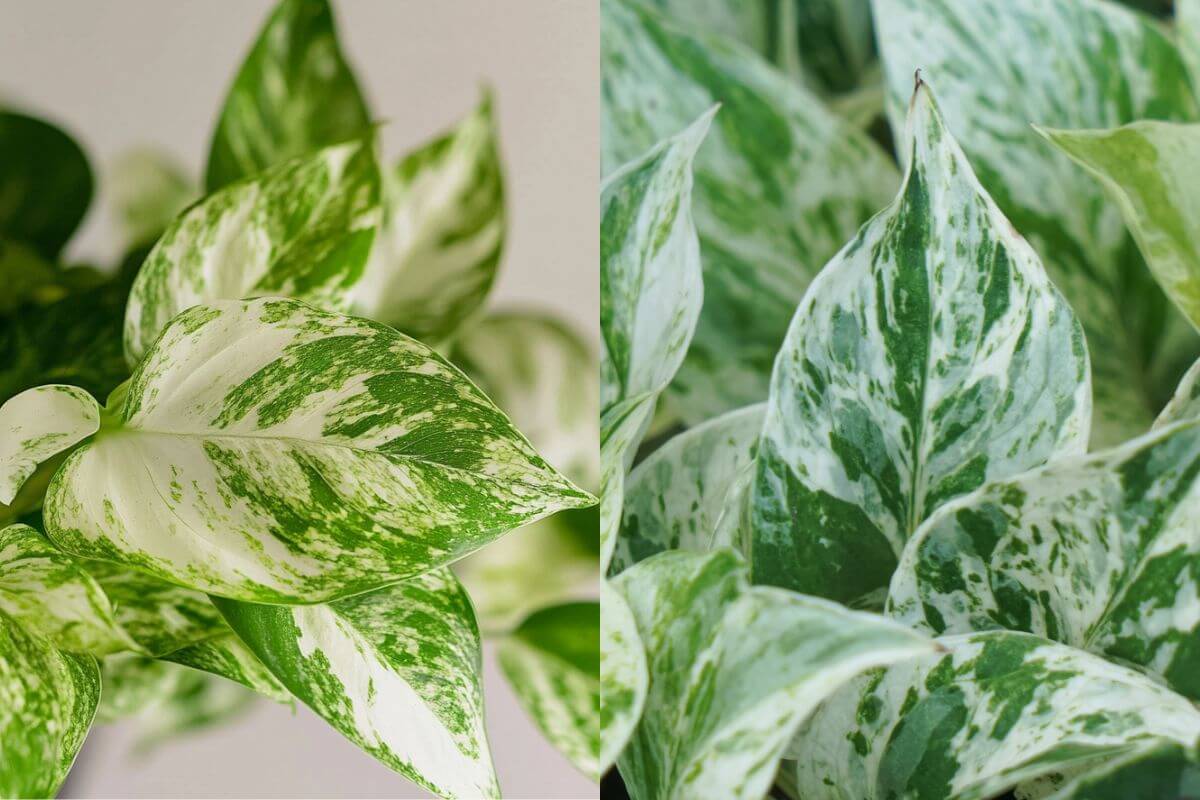
Many members of the Pothos group are botanically known as the Epipremnum aureum including both the Snow Queen and Marble Queen, so they are very closely related, just like sister plants.
The principal difference can be noted in their foliage if observed closely.
Leaf Types, Shapes, and Variegation
At a distance, these two plants can be easily mistaken for one another, but upon closer examination, the leaves do show differences in leaf texture and shape.
The foliage of the Marble Queen Pothos is thicker in texture, and it veins will be deeper and more apparent than on Snow Queen leaves. Its foliage is narrower with edges and ends that tend to curl. That gives the plant a bushier and fuller appearance.
The Snow Queen leaves may appear straighter, and wider in both size and shape. They may also appear to have fewer indentations horizontally along the edges of the leaf.
Both of these plants have foliage that feels waxy, with a texture that feels as if it is raised when touched. Both plants have heart-shaped leaves growing directly from their vines.
Pothos vs Philodendron Tip: If your plant’s leaves grow from a sheath instead of a vine, your plant is most likely a philodendron and not a pothos.
On both the Marble Queen and Snow Queen, leaves will grow from leaf nodes along the vines.
What distinguishes these two divas of the plant world, is the foliage’s color. The Snow Queen will feature a delicate light green tint on a white background and the white will be a bright white.
The green color on Marble Queen leaves is darker and glossier. The white variegation appear to be more cream-colored, rather than a bright white color.
If you have the opportunity to observe them closely when placed side by side, the color variations will be clearly apparent. You’ll notice that the Snow Queen is approximately 75% to 80% white with the remainder green, whereas the Marble Queen will divide white and green variegation more evenly at about 50-50%.
Baby leaves on both plants will appear to have different shapes and sizes but will eventually mature into the well-known heart-shaped leaves characteristic of the Pothos.
Petioles
The plant stalk that attaches a stem to a leaf blade is referred to as a “petiole.” The petioles are crucial to the health and welfare of your plant as they protect your plant and structurally support the leaf attachment.
Petioles contribute to a plant’s growth and help in the furnishing of nourishment from the roots to other parts of the plant, including the leaves and eventual blooms.
Pothos plants have petioles that are indented and round. There is no real difference between Snow Queen petioles and Marble Queen petioles.
The only visible difference, and you need to be looking for it, is in the color. Marble Queen petioles are green, while some of the Snow Queen’s petioles may be white as it has less chlorophyll.
Aerial Roots
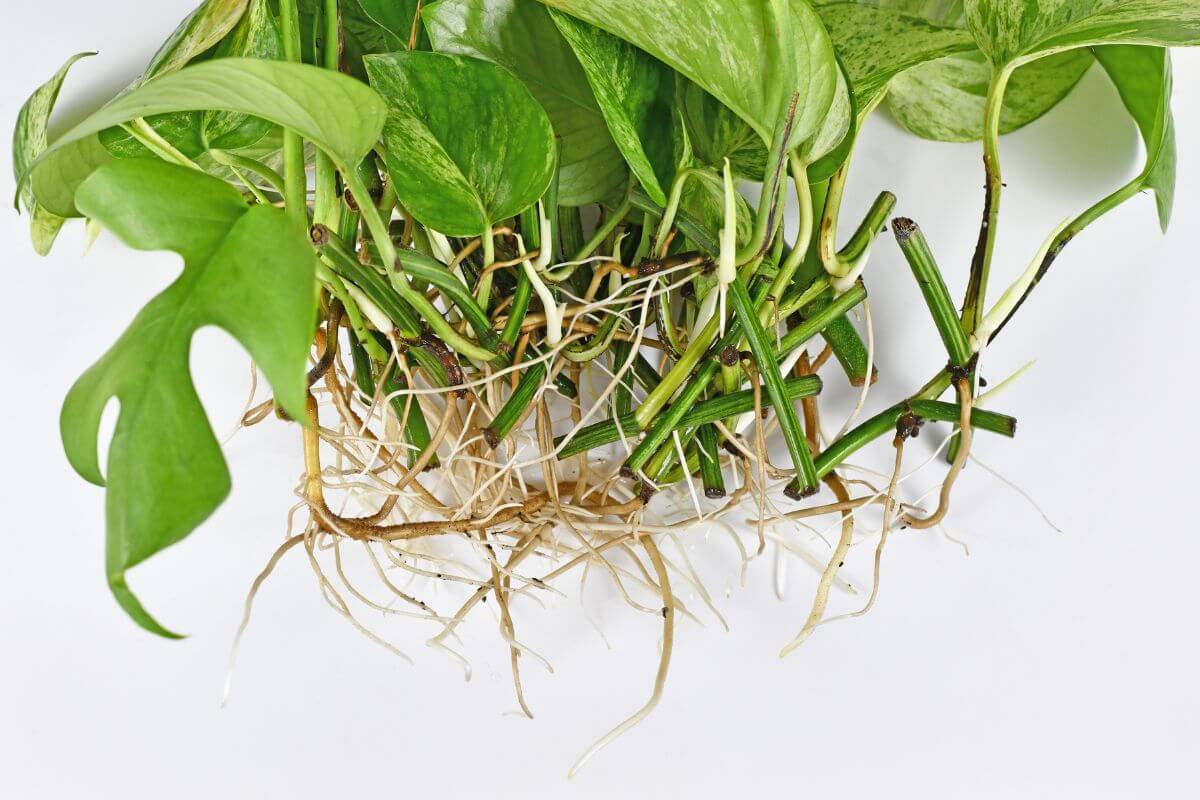
Apart from the typical root ball found on these two kinds of Pothos, they also both produce what are known as aerial roots.
An aerial root is a kind of root that will grow out of the stem or vine, but above the surface of the soil. They grow in the air, thus aerial. They appear as short blades emerging from the vine.
Both the Marble Queen and the Snow Queen produce these aerial roots, and they make it easier for the Pothos vines to climb.
Vines
Pothos plants are vining plants, meaning they can climb, trail, cascade downward from a high perch, and can even be tamed to become a bushy, stand-up tabletop plant. This is true for both the Snow Queen and the Marble Queen.
Whereas the Marble Queen may grow more slowly than the Snow Queen, both can develop impressive vines when cared for properly.
The Snow Queen has a fuller appearance, is smaller, and consequentially requires less trimming and pruning. If you want to avoid a lot of pruning, the Snow Queen will probably be easier to take care of than the Marble Queen.
Both Pothos Queen vines can grow to a gorgeous 5 to 6 feet long. In any case, both Queens will look stunning while vines are cascading down from hanging baskets, or climbing along poles, trellises, or walls.
It is relatively easy to create a climbing path for them as they will cling to various kinds of surfaces using their aerial roots.
Growth Rates
Most varieties of pothos are rapid growers, but the Snow Queen is an exception. It will grow slightly slower than the Marble Queen, but the growth rate difference is minimal.
This is due to the Marble Queen containing much more green in its foliage from higher levels of chlorophyll, which in turn, do more photosynthesis, translating into more vigorous growth.
If you want a lot of growth, opt for the Marble Queen. If you prefer a compact plant, consider the Snow Queen Pothos.
Snow Queen vs Marble Queen Pothos Care
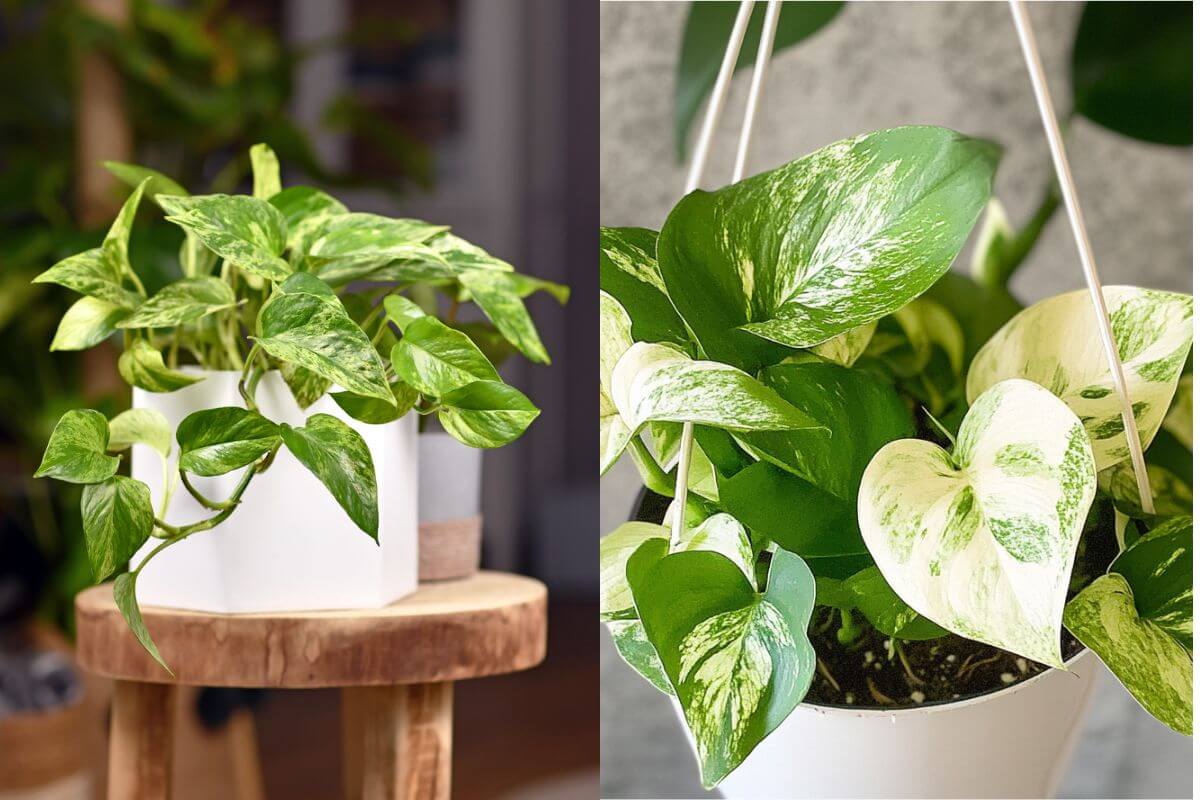
Soil and Growing Medium
The best growing medium for any Pothos cultivar is loose, well-draining potting mix that allows for aeration, and is rich in nutrients.
Ideally, a third of your potting mix should be perlite, sand, orchid bark, or coco coir. In other words, a portion of the potting mix should guarantee good drainage, moisture retention, and aeration.
Avoid using soil from your backyard garden as it may be too heavy and have pests.
For optimal results, the soil pH level needs to be a little acidic, measuring in a range between 6 and 6.5.
The ideal pot container for either plant needs to have a sufficient number of drainage holes in the bottom. That will help prevent soggy soil and overwatering issues like root rot.
Because the Marble Queen is a more vigorous grower, it may require a larger pot and need to be repotted more often.
Lighting Needs
The amount of light you provide will influence the leaf color and the amount of variegation. Most variegated pothos varieties enjoy medium-bright indirect sunlight and that’s true of the Marble and Snow Queen plants.
Both Queens enjoy and prefer lots of bright light that is indirect. If you decide to have one of each, you can position them together as their lighting needs are the same.
If they receive too much light, their foliage colors will fade, while too little light will have foliage turning greener. Also, be careful not to scorch leaves with exposure to direct sunlight.
Both indoor plants will do well in east or west-facing windows or nearby.
Temperature and Humidity Needs
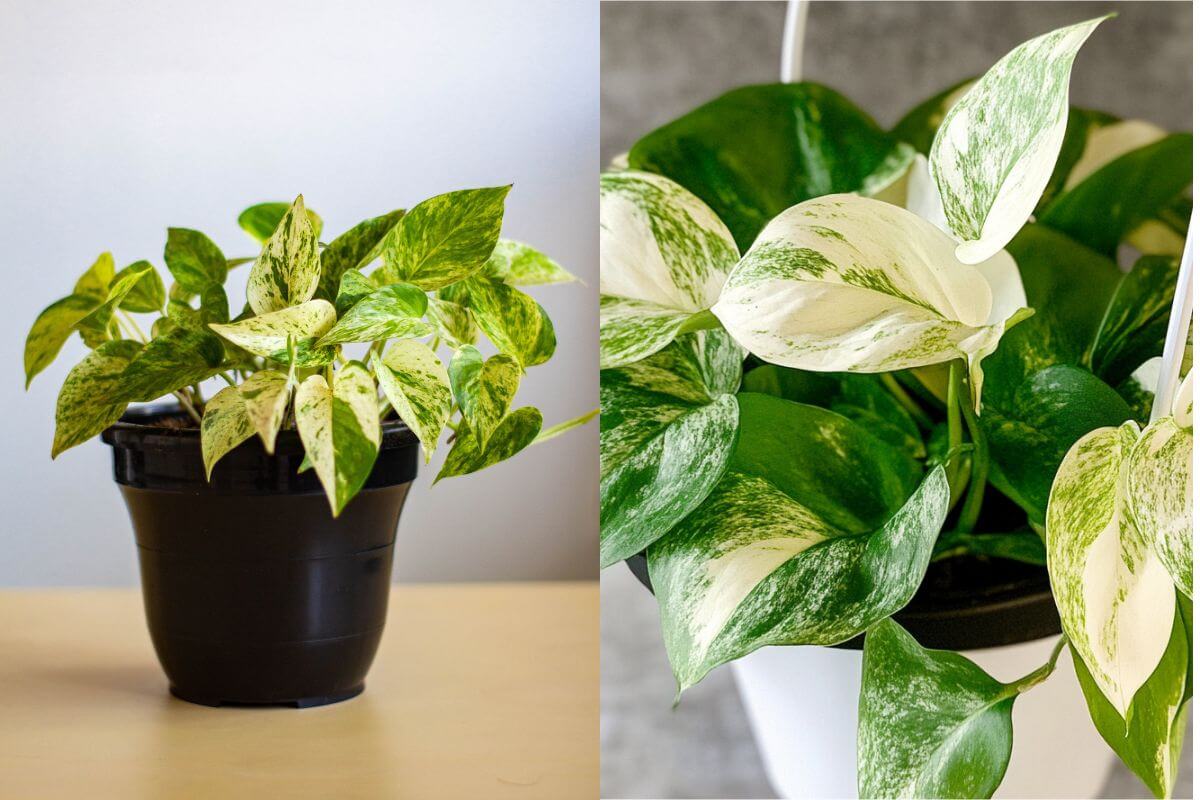
The Marble Queen and the Snow Queen will both thrive in temperatures ranging from 60° to 80° Fahrenheit.
Both are tropical plants, so they prefer average to higher humidity levels.
Watering Needs
As tropical plants, the Queens need and enjoy moisture, but good drainage is the key not only to their survival, but to their beauty as well. If your pot fails to drain excess water, it will lead to root rot and eventually kill the plant.
A weekly soaking is a good idea for both plants. Place them under a running tap for about ten seconds and then leave them in the sink or tub to drain thoroughly.
These plants would be good to water once every 7 to 10 days depending on your local climate. Check the soil in your home to know how often you need to water in your area.
Check the soil to see if it’s dry by sticking your finger down into the soil bed. If the soil feels dry, your Pothos is ready for a drink. Water needs may increase in warmer weather and need to be reduced during the winter.
Fertilizer Needs
As light feeders, the Marble Queen and the Snow Queen do not really require fertilizer.
If you want to play it safe and even increase its growth rate, give a monthly feeding of an all-purpose liquid houseplant fertilizer diluted to half strength during the growing season.
You can also try different types of fertilizers like an aroid fertilizer or NPK 10-10-10 fertilizer. Worm casting are another good solution as an organic fertilizer.
Pruning Needs
Both your Marble Queen Pothos and the Snow Queen Pothos should be pruned of any dead, dying, or damaged leaves.
As a general rule, you can trim both plants twice annually, or every six months.
If you want a bushy appearance as a tabletop plant, trim the long vines regularly to the desired shape. This will also encourage new growth.
The Marble Queen is the more vigorous grower of the two plants, so it may require more trimming.
Problems, Pests, and Diseases
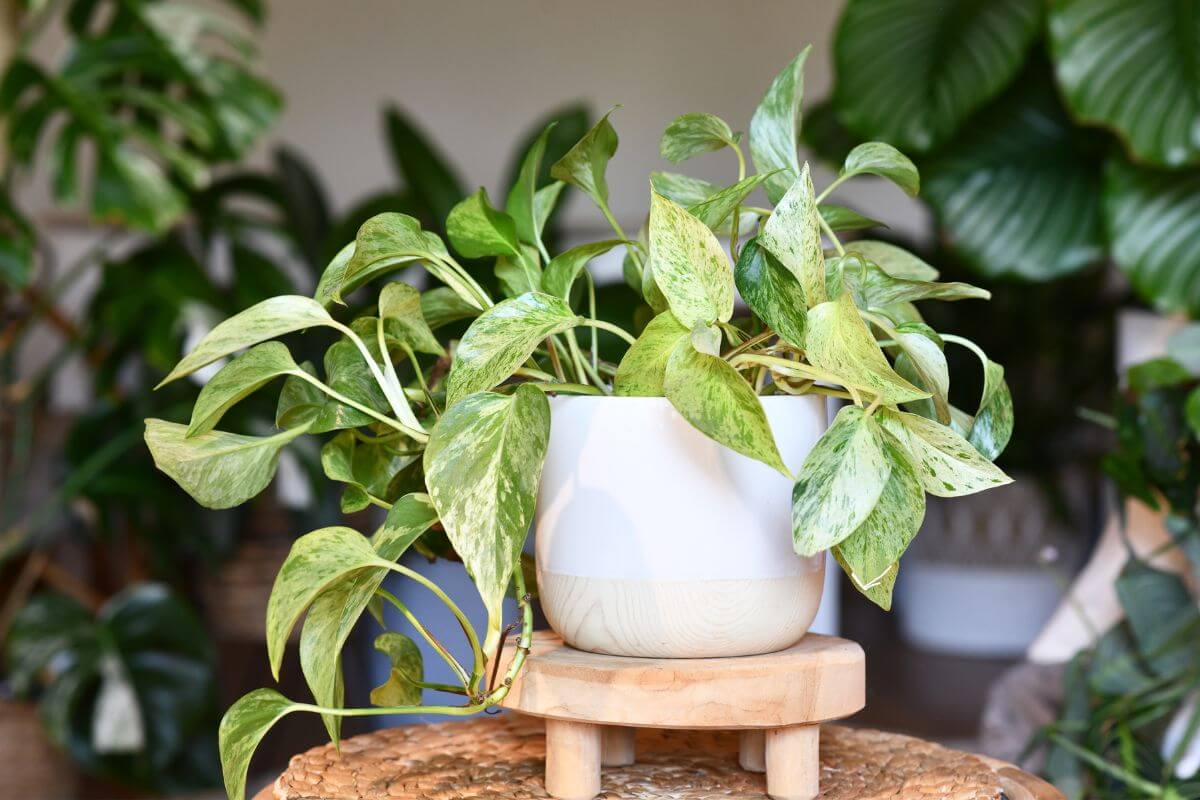
Both are susceptible to common houseplant pests such as aphids, spider mites, mealybugs, scale, or thrips.
All can be treated by manually removing pests and then by treating them with an organic insecticidal soap or neem oil.
Both plants are susceptible to fungal diseases, although the Snow Queen is more so.
To help the Snow Queen prevent fungal infections, make sure it has sufficient room around it to ensure good air circulation.
Should you notice brown spots on leaves, spray with an organic fungicide. This may need to be repeated a few times as one application may not be enough.
Snow Queen vs Marble Queen Pothos Final Thoughts
These sister plants share similar characteristics and needs, while also having their differences.
The Snow Queen distinguishes itself for its beautiful white leaves with variegations, while the lovely Marble Queen seduces with a darker, glossier green.
Both of these Pothos plants are striking and will most certainly attract attention wherever they are located Even more reason to have one of each!
Here are guides to other popular pothos varieties like the Golden Pothos:


